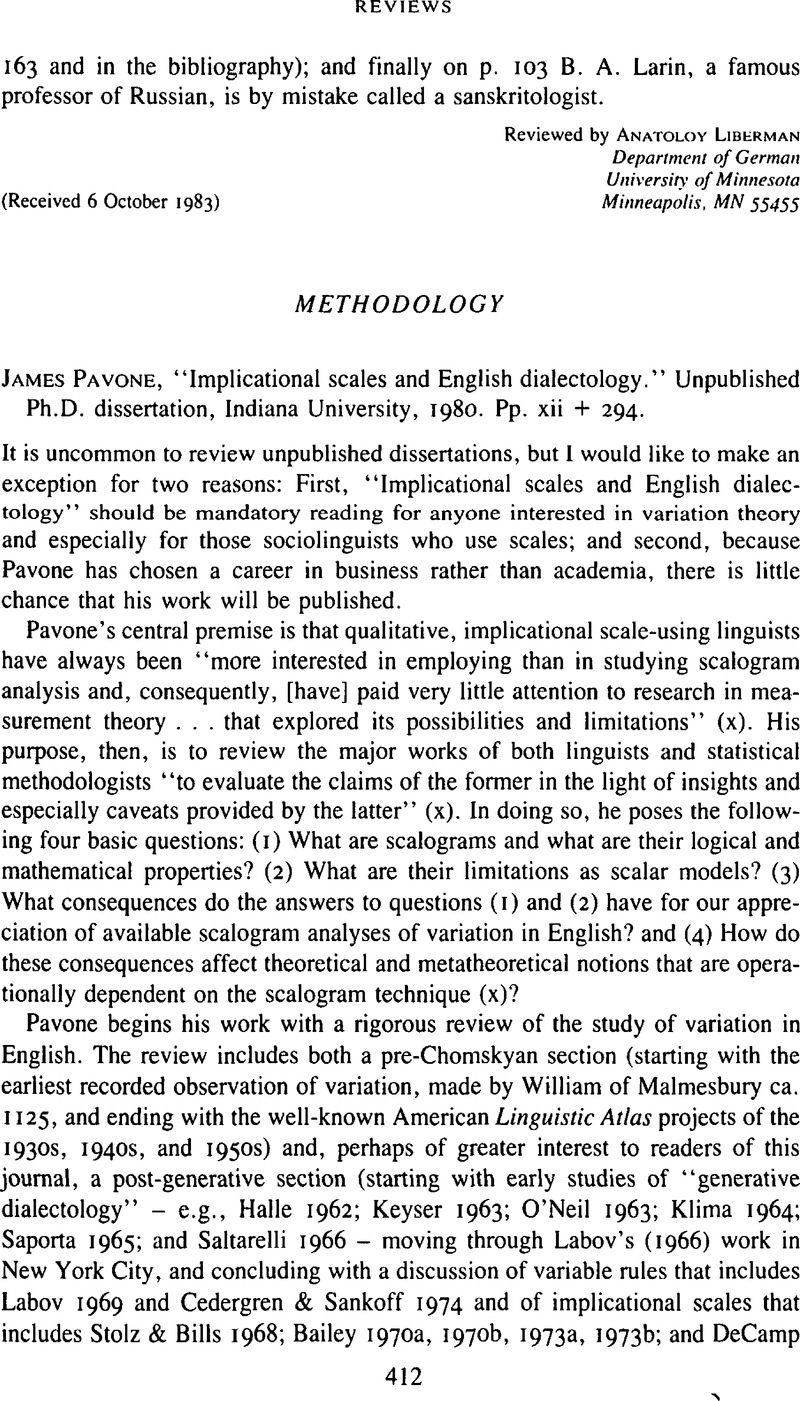No CrossRef data available.
Article contents
Methodology - James Pavone, “Implicational scales and English dialectology.” Unpublished Ph.D. dissertation, Indiana University, 1980. Pp. xii + 294.
Published online by Cambridge University Press: 18 December 2008
Abstract
An abstract is not available for this content so a preview has been provided. Please use the Get access link above for information on how to access this content.

- Type
- Book Review
- Information
- Copyright
- Copyright © Cambridge University Press 1984
References
REFERENCES
Anshen, F. (1973). Some data which do not fit some models. In Bailey, C-J. N. & Shuy, R. W. (eds.), New ways of analyzing variation in English. Washington, D.C.: Georgetown University Press. 62–68.Google Scholar
Bailey, C.-J. N. (1970a). Using variation to confirm, rather than undermine, the validity of abstract Syntactic structures. Working papers in linguistics University of Hawaii, 2, No. 8, 77–86.Google Scholar
Bailey, C.-J. N. (1970b). Building rate into a dynamic theory of linguistic description. Working papers in linguistics University of Hawaii, 2, No. 9, 161–233.Google Scholar
Bailey, C.-J. N. (1973a). The patteming of language variation. In Bailey, R. W. & Robinson, J. L. (eds.), Varieties of present-day English. New York: Macmillan. 156–86.Google Scholar
Bailey, C.-J. N. (1973b). Variation and linguistic theory. Arlington, Va.: Center for Applied Linguistics.Google Scholar
Bickerton, D. (1971). Inherent variability and variable rules. Foundations of Language 7:457–92.Google Scholar
Bickerton, D. (1973a). Quantitative versus dynamic paradigms: The case of Montreal que. In Bailey, C.-J. N. & Shuy, R. W. (eds.), New ways of analyzing variation in English. Washington, D.C.: Georgetown University Press. 23–43.Google Scholar
Cedergren, H., & Sankoff, D. (1974). Variable rules: Performance as a statistical reflection of competence. Language 50:333–55.CrossRefGoogle Scholar
Day, R. R. (1972). Patterns of variation in copula and tense in the Hawaiian post-creole continuum. Ph.D. Dissertation, University of Hawaii.Google Scholar
DeCamp, D. (1971a). Toward a generative analysis of a post-creole continuum. In Hymes, D. (ed). Pidginization and creolization of languages. Cambridge University Press. 349–70.Google Scholar
DeCamp, D. (1971b). Implicational scales and sociolinguistic linearity. Linguistics 73:30–43.Google Scholar
DeCamp, D. (1973). What do implicational scales imply? In Bailey, C-J. N. & Shuy, R. W. (eds.), New ways of analyzing variation in English. Washington. D.C.: Georgetown University Press. 141–48.Google Scholar
Elliott, D., Legum, S., & Thompson, S. (1969). Syntactic variation as linguistic data. In Binnick, R. et al. (eds.), Papers form the Fifth Regional Meeting of the Chicago Linguistic Society, April 18–19. 1969. Chicago: Department of Linguistics, University of Chicago. 52–59.Google Scholar
Fasold, R. W. (1970). Two models of socially significant linguistic variation. Language 46:551–63.Google Scholar
Keyscr, S. J. (1963). Review of Kurath, H. & McDavid, R. I. Jr, The pronunciation of English in the Atlantic states (Ann Arbor: University of Michigan Press, 1961). Language 39:303–16.Google Scholar
Klima, E. S. (1964). Relatedness between grammatical systems. Language 40:1–20.CrossRefGoogle Scholar
Labov, W. (1966). The social stratification of English in New York City. Washington, D.C.: Center for Applied Linguistics.Google Scholar
Labov, W. (1969). Contraction, deletion, and inherent variability of the English copula. Language 45:75–62.Google Scholar
O'Neil, W. A. (1963). The dialects of modem Faroese: A preliminary report. Orbis 12:393–97.Google Scholar
Rickford, J. R. (1975). Carrying the new wave into syntax: The case of Black English bin. In Fasold, R. W. & Shuy, R. W. (eds.), Analyzing variation in language. Washington, D.C.: Georgetown University Press. 162–83.Google Scholar
Saporta, S. (1965). Ordered rules, dialect differences, and ordered processes. Language 41:218–24.CrossRefGoogle Scholar
Stolz, W., & Bills, G. (1968). An investigation of the standard–nonstandard dimension of central Texan English. Austin: University of Texas Child Development Evaluation and Research Center.Google Scholar


